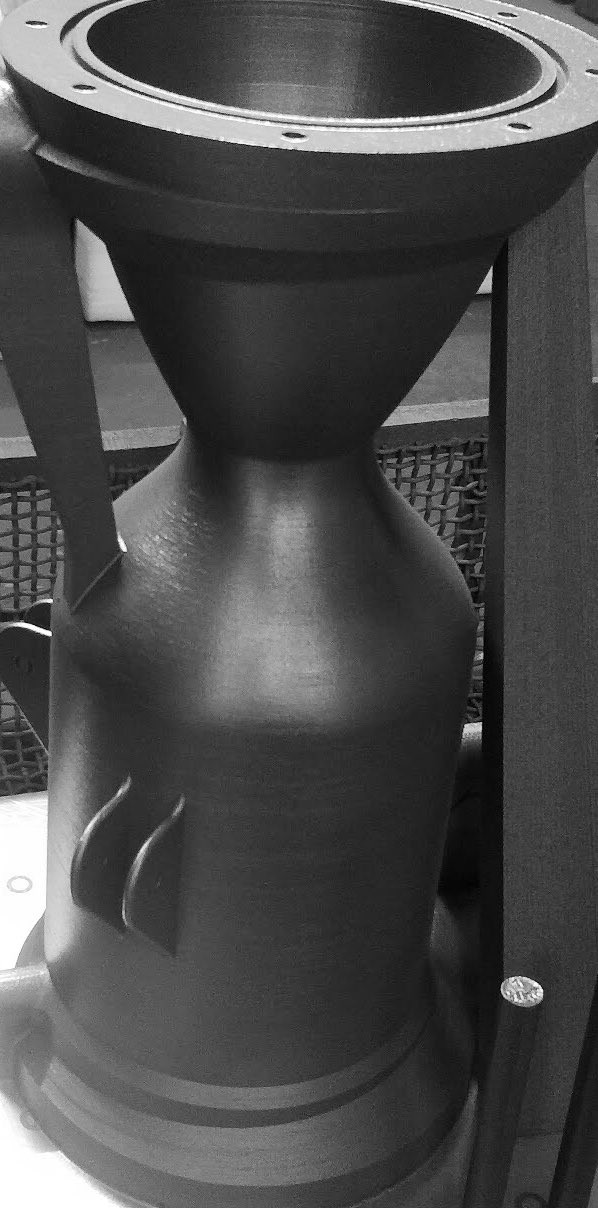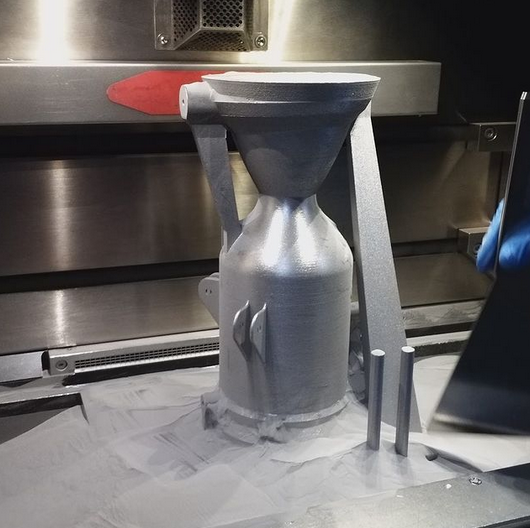Indian space startup AgniKul Cosmos has developed and test-fired a fully 3D printed rocket engine. Produced as a single component in one run, the higher stage semi-cryogenic liquid propulsion engine called Agnilet was built to support its orbital-class launch vehicle Agnibaan. Even though several space agencies and companies are using additive manufacturing (AM) to churn out rocket parts and engines – most notably SpaceX, Relativity Space, and NASA –, AngiKul claims Agnilet is the first single-piece 3D printed rocket engine to pass a fire test successfully.
Igniters, injectors, cooling channels, mounts, manifolds for fuel and oxygen, and nozzle are just a few of the hundreds of components that go into making a rocket engine. Moreover, most of these are incredibly complex geometries that traditionally require several conventional fabrication techniques and machining processes, such as welding, brazing, and drilling, to create a flight-worthy engine. However, AM is helping reduce the lead time and costs that go into making a rocket engine.
For the team of engineers at AgniKul, 3D printing technology brings down the time taken to make the rocket engine to less than 72 hours. More importantly, the single part that comes out of the machine is ready to be fitted in a space vehicle after standard post-processing. The company claims that once they are prepared to launch their Agnibaan two-stage vehicle, it will be capable of taking up to 100 kg to orbits around 700 km high. The rocket is expected to carry micro- and nano-satellites to low Earth orbit (LEO) on-demand starting in 2022.
One of the unique features of Agnibaan is its configurability. The number of engines that go on the first stage depends on the mission, the payload, and the launch port, which means 3D printing entire engines will be efficient. Especially if AgniKul is hoping to offer customers a two-week timeline from payload integration to rocket launch. This short wait period will help ramp up the small satellite launch industry, which is currently forced to piggyback on larger missions as even small rocket launches remain too expensive.
The space tech startup’s Co-Founder and CEO, Srinath Ravichandran, said: “This entire engine – Agnilet – is just one piece of hardware from start to finish and has zero assembled parts. We don’t think anyone in the world has ever pushed 3D printing of a rocket engine to this extent, and we couldn’t be happier to have conceived, designed, realized, and test-fired this engine fully in India.”
Fully designed and realized in India, the Agnilet engine being tested at the Indian Institute of Technology (IIT) Madras was the sea-level version and is regeneratively cooled as it would be in flight. Seven of these engines are expected to power Agnibaan’s first stage, each delivering 25 kiloNewtons (kN) of thrust at sea-level. They are electrically pumped, allowing for simplified engine design and highly configurable engine clustering architectures.
Based out of the Eastern Indian city of Chennai, on the Bay of Bengal, AngiKul is developing India’s first private small satellite launch vehicle and is conducting tests with the help of the country’s national space agency, the Indian Space Research Organisation (ISRO). Founded in 2017, the IIT Madras incubated startup received a much-needed boost with the announcement of the Indian National Space Promotion and Authorisation Centre (IN-SPACe), an autonomous body under the Department of Space, which has helped private players gain access to ISRO infrastructure.

AgniKul’s single piece fully 3D printed semi cryogenic engine Agnilet. Image courtesy of AgniKul Cosmos.
India’s space economy is valued at $7 billion, which is around 2% of the global space economy, currently pegged at $360 billion, according to PricewaterhouseCoopers (PwC) estimates. But the country is aiming higher through the development of a self-sufficient ecosystem with many more new small manufacturers. Recent space reforms announced in 2020 by Prime Minister Narendra Modi’s government have allowed private players and startups to enter India’s space sector and eventually unlock its potential.
As reported by the India Global Business media outlet, the reforms envisage private and even foreign companies in the space sector to use ISRO’s infrastructure and facilities, scientific and technical resources, and even data for their space programs. Other players in the small satellite vehicle ecosystem include the Bangalore-based startup Bellatrix Aerospace, which builds a launch vehicle designed to deliver a 50 kg payload. Along with Skyroot Aerospace, a startup that recently revealed its fully 3D printed cryogenic rocket engine named Dhawan-I.
The private sector has ramped up investment in space and is powering a new era of space commercialization, and India’s hyperactive startup ecosystem – the third-largest in the world – is not planning on lagging. With AM continuing to disrupt the space industry, startups can get a head start and manufacture parts with shorter lead times and more competitive costs than ever before. A perfect example of using 3D printing technology to its fullest, AgniKul’s Agnilet is literally just one piece of hardware from start to finish and has zero assembled parts.
Subscribe to Our Email Newsletter
Stay up-to-date on all the latest news from the 3D printing industry and receive information and offers from third party vendors.
Print Services
Upload your 3D Models and get them printed quickly and efficiently.
You May Also Like
Inside AM’s Quiet, Strategic Revolution: An Interview with Dyndrite Founder, Harshil Goel
Founded in 2016 by Harshil Goel, Dyndrite has been clear in its mission from the start: namely, “to fundamentally change how geometry is created, transformed, and transmitted on a computer.”...
3D Printing News Briefs, August 20, 2025: Tool Steel Alloy, Microstructure Control, & More
Today’s 3D Printing News Briefs is all about materials, from recycled metal replacements and a new high-strength alloy to microstructure control in nickel-based superalloys and more. Read on for all...
3D Printing News Briefs, July 23, 2025: ASTM Standard, Defense, Bioinks, & More
We’re starting with business news in today’s 3D Printing News Briefs, as Nikon AM Synergy has appointed a new CEO. Moving on, a proposed ASTM International standard will support 3D...
From Concept to Reality: Nikon AM CEO Hamid Zarringhalam on Executing a Metal 3D Printing Strategy
There are countless metrics you can use, whether quantitative or qualitative, to judge the success of an organization. One of the most important may simply be the organization’s ability to...

































